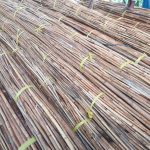Rattan is one of Indonesia’s natural resources that we should be proud of. How come? Indonesia is the largest rattan producer in the world. About 80% of the world’s rattan production is produced from forests on the islands of Kalimantan, Sulawesi, Sumatra, to Papua. In terminologically rattan is a vine that grows from the Palmae family. The name rattan is thought to have come from the Malay language, namely “Raut” which means to peel, or smooth. Morphologically, rattan is known as a fast-growing plant that vines or climbs on the surrounding trees. The tropical climate in Indonesia makes rattan a suitable plant on Indonesian soil. Various types of rattan exist in Indonesia.
In general, rattan is divided into two types. Namely natural rattan and synthetic rattan. One of the advantages of natural rattan lies in its color. The colors that appear in natural rattan are natural colors. The nature of natural rattan is still pure and has not been mixed with anything. Therefore, natural rattan has a very high authentic value. Natural rattan is more durable and long lasting. The manufacturing process is also easier and relatively fast. However, natural rattan is less resistant to water and sunlight, which is why natural rattan should be placed indoors only.
Unlike natural rattan, synthetic rattan is much more recommended for furniture purposes. Synthetic rattan as a substitute for natural rattan, made from plastic or synthetic raw materials. The material is processed in such a way through a fabrication process to produce artificial rattan. More advantages will we get if we choose synthetic rattan. Synthetic rattan is more environmentally friendly because of the increasing demand for natural rattan. In addition, the advantages of synthetic rattan are the many color choices that we can choose from. Unlike natural rattan which only has one natural color, synthetic rattan actually has many color variations. Because it is made from synthetic materials, the coloring is more diverse. Unlike natural rattan which is not waterproof, synthetic rattan can withstand extreme weather. Apart from termites, the weather factor is also a factor in destroying rattan-type materials. However, with synthetic rattan, products made from rattan are more durable and resistant to water and sun exposure. The thing that surprises us the most is that synthetic rattan is cheaper than natural rattan. The ease of synthetic rattan material also encourages the availability of stock that is always there. This convenience makes production costs cheaper.
After the explanation of synthetic rattan and natural rattan, we know better which rattan we should choose as furniture. Behind every disadvantage and advantage, in fact, rattan still has its own enthusiasts for now and in the future. Rattan furniture always has an expensive artistic value compared to other furniture products.



